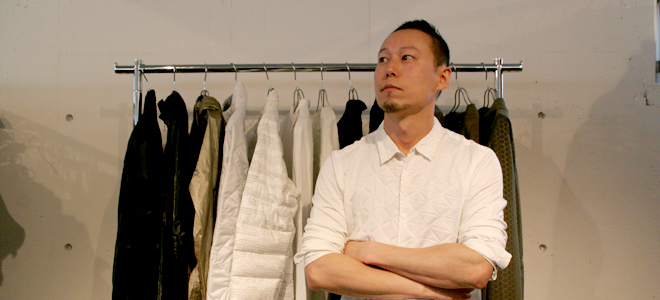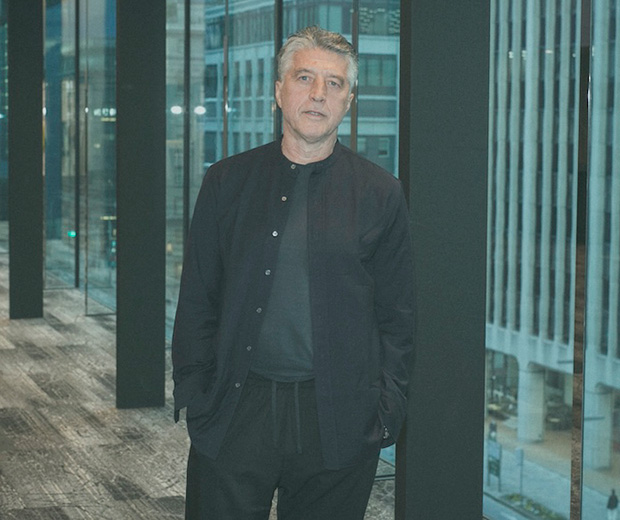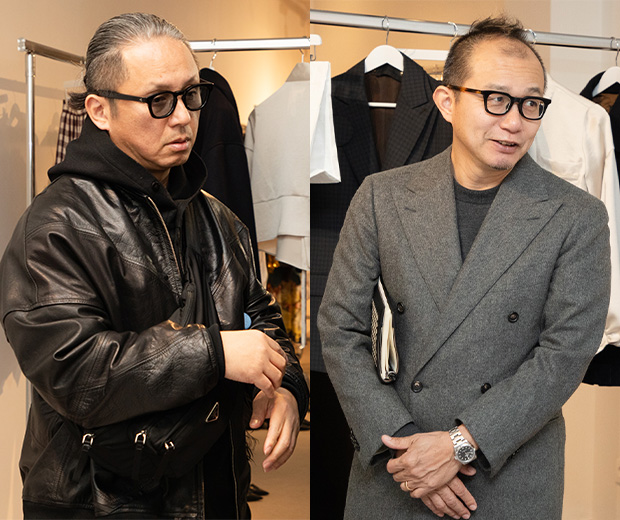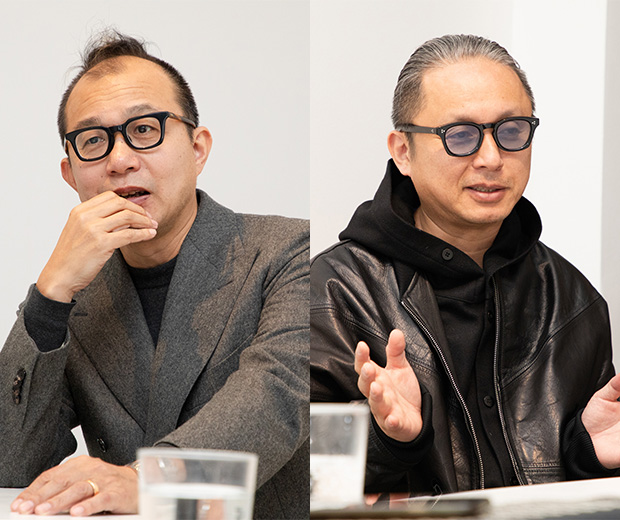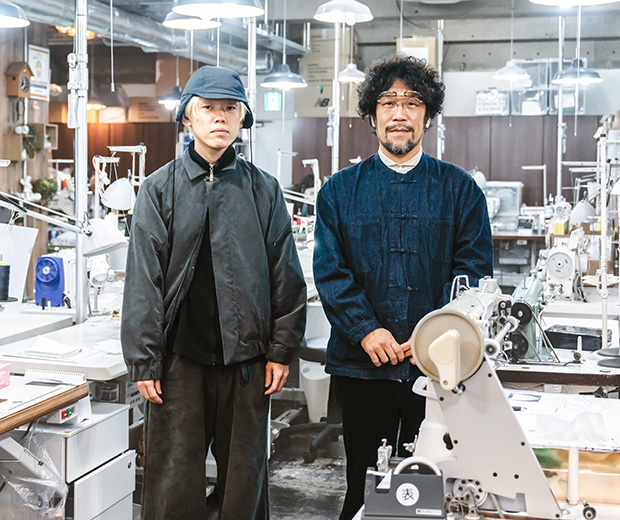TAKASHI MORI
MOLFIC pursues a “new universality” that fits the modern lifestyle, actively developing materials centered on synthetic fibers. The sharp and minimalistic collection designed in monotone colors has brought a breath of fresh air into a Tokyo’s fashion scene, in which the casual style is now mainstream. We interviewed the brand’s designer, Takashi Mori, a designer not influenced by seasonal trends and whose designs are pursuing a a consistent story over a long period of time.

An embossed motif knitwear
What is the theme for your 2010-11 Autumn/Winter collection?
Mori: I do not have a clear-cut theme for each season. Rather than announcing a different theme every six months, I’m looking for a new universality. But of course, things that interest me now are naturally reflected in my collection. For this collection, these were images of airports and runways. I was interested in the image of runways dividing, with each journey branching out in a network. I used the resulting hexagon pattern as an embossed motif in my work.
You always actively work on the development of materials. Was there anything you focused on in particular for this collection?
Mori: I did a lot of research on the expression of knitwear embossing . The material is 100% polyester, and we made the yarn ourselves. We spool knit the material using hollow yarn, intentionally making the material thicker in order to bring out the embossing effectively while also making the material much lighter than it looks. I am also developing a mobile suit which can be packed and carried around in three types of materials, including jersey and wool-blend. I consider this one of my life’s works.
Why did you choose to make mobile suits your life’s work?
Mori: With the evolution of the Internet, we have access to an ever-increasing amount of information and everything is becoming faster. I want the clothes we wear to evolve along with this trend. For instance, I go on business trips a few times each year, but when I take a suit with shoulder pads on my trips, I need a garment bag to keep the suit looking nice. If I was able to pack the suit into the size of a laptop and carry it around in my backpack, My hands would be free to do other things. I chose mobile suits as my life’s work because I want to make clothes that can improve lifestyle.

So this leads to your notion of a “new universality.”
Mori: That’s right. I am particular about the materials I use for the same reason. Not in the sense that I need to use rare and expensive materials, but by pursuing light and soft materials, I hope to make clothes that can liberate people from various stress factors. For instance, I make shirts out of jersey material, but rather than make the shirt casual because of its material, I want the shirt to be looking sharp and minimalistic, and enhance its quick-drying ability so that if you wash it at night on a business trip, the shirt would be dry in the morning.. Fashion has the power to enrich people mentally, but I think that it can also make people happy in the physical sense, too.



When did you start becoming interested in making such clothes?
Mori: Perhaps when I was around twenty . I worked later as a designer at ISSEY MIYAKE for five years. I was greatly influenced by that company’s excellence in materials development and by its attitude to fashion – they did not limit themselves to clothes, but also extended their reach to art and architecture. I think this experience led me to who I am today.
You made your runway debut with the 2011 Spring-Summer collection. You had been in charge of music for the shows of SOMARTA, which is also a brand of SOMA DESIGN, but how was it to hold a fashion show as a designer for MOLFIC?
Mori: To be honest, I was quite skeptical about runway shows at first. Clothes that pursue functional beauty such as those of MOLFIC do not lend themselves easily to shows, and when looked at in photos or video images, since colors are monotone, the embossed details are easily crushed. But once we hammered out the details of the performance, choosing lighting that brought out the embossments and considering the distance between the models and the audience, the live audience-feel unique to shows felt great. The models expressed well the movement of the clothes and the ending performance was a success too, so I’m glad that we did it. The best part of a show is that you can create your own world, including space, music, and time-line. However, I do not believe that shows are the only way to present a collection. Since I live in the chaotic city known as Tokyo, I would like to think of methods that represent my clothes in even deeper ways, taking into account new technologies as well.







* Click here for the 2011 S/S collection
Are you strongly conscious of transmitting your work from Tokyo?
Mori: Since I was raised in Tokyo, I think my work naturally has that sense of “Tokyo-ness”, so I don’t feel that I need to be too conscious of it. If I’m too conscious of it, I think I may become confined to a “Tokyo” stereotype. The images of Japan and Tokyo portrayed abroad are often distorted, funny, and focus on the visually “kawaii” culture. I want to convey more the cool aspects of Tokyo. However, I want to embrace the world evenly, regardless of Japan or abroad. But I do wish for my hometown Tokyo to regain its liveliness.
This is likely to become a big issue due to the earthquake. The MOLFIC runway show was also cancelled because of the earthquake. In the future, what kind of mindset will you have as you work on your creations?
Mori: MOLFIC aims to enrich people’s lives by providing functionality rather than embellishments and appearance, so I hope to be able to help wherever I can. This will not change because of the accident andmy mindset as a designer will not drastically change either. Leaving that aside, the accident made all the things that we had taken for granted before fall apart, and I personally hope that things will change and that many people will start thinking on their own. I hope that rather than being too affected by immediate problems, people will understand that things take time and will become more conscious that enjoying the ride is important.
This overlaps with your brand’s approach of continuously pursuing a consistent theme.
Mori: I think there are some things that cannot be seen unless you spend a long time researching it. We live in a time where everything is superficial,. If everything changes quickly, I feel like we will only be left with a sense of emptiness. I feel that what is necessary in the world today is diversity. I do not intend to deny trends at all, but I feel that it is also necessary to know that different things exist. For instance, I think many people appreciate the quality of natural fibers, but do not know the quality of synthetic fibers. However, this is the fruit of human knowledge. I believe that conveying these facts to people is my role as a MOLFIC designer.

